Chinese Dreams, Indian Nightmares: Does BRI Imply a Collision Course?
archive

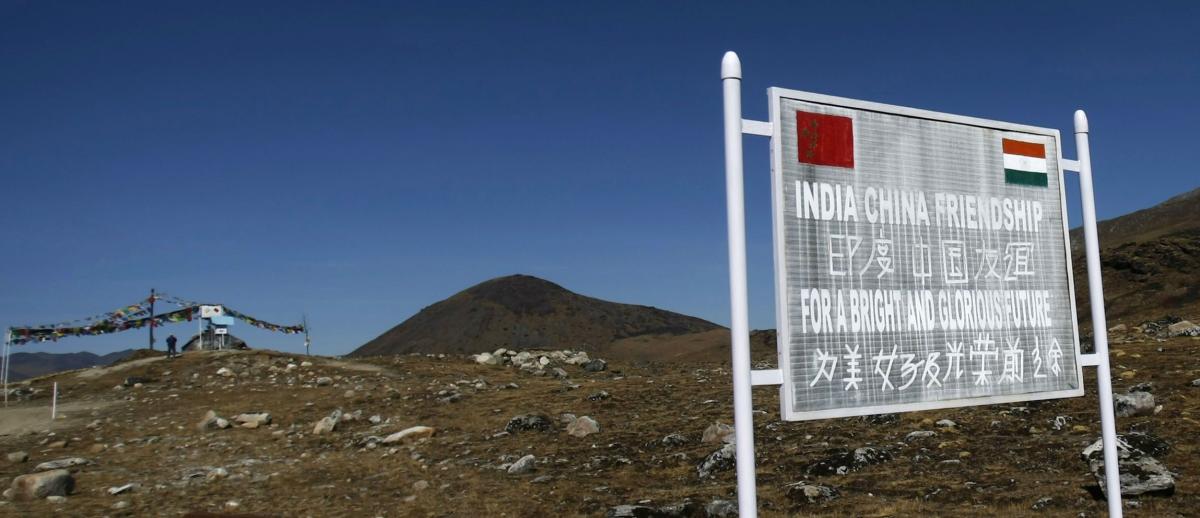
Chinese Dreams, Indian Nightmares: Does BRI Imply a Collision Course?
This past summer, China and India came close to war during their military stand-off in the strategically important Doklam region, a high plateau in the Himalayas close to the Indo-China border. Indian troops swiftly entered to stop a Chinese road building project on disputed territory, claiming the Chinese were violating the territorial sovereignty of India and its close ally, Bhutan. If completed, this project would give China access to India's vulnerable ‘chicken's neck’, a 12-mile wide corridor that links the seven north-eastern states of India to the mainland. Whilst minor skirmishes along the 2,200 mile Indo-China border are common, in this case bellicose rhetoric signalled real fears of conflict, evoking memories of the 1962 Sino-Indian war. Although wise diplomacy won the day and all the sides agreed to disengage, troop build-up in the region continues. This incident is symptomatic of a greater power game between India and China for regional and global dominance, at whose core is China’s vigorous pursuit of its Belt and Road Initiative (BRI, formerly One Belt, One Road) linking East with West, countering Kipling’s dictum that the two domains could never meet.
This essay explores global ambitions of the world’s two most populous nuclear nations through their contrasting narratives on BRI, and their potential impacts on South Asian and global dynamics in the coming decades. China’s BRI constitutes an important part of its geostrategic design to rejuvenate its old glory by capturing global economic leadership. India, in contrast, perceives BRI as signalling imminent danger of Chinese dominance of the South Asian region, threatening regional security and thwarting its aspirations of gaining a permanent seat on the UN Security Council. India also worries that the BRI could intensify its proxy war with Pakistan over Kashmir on its western border, and unleash yet another conflict on its eastern border. Given the high stakes, both countries are actively mobilizing their diplomatic and financial capital to retain or win allies among their neighbours.
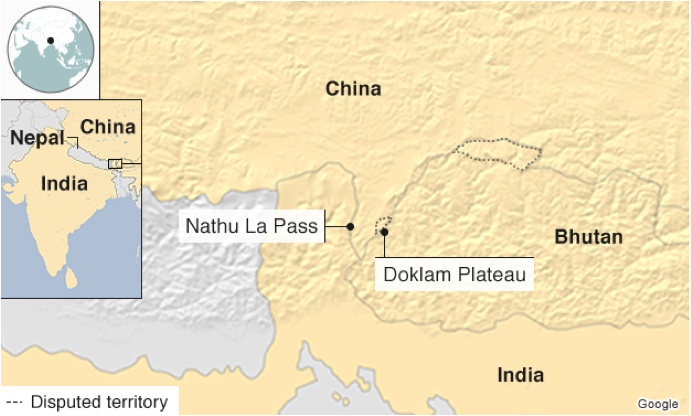
Rise of China and its Global Aspirations
China’s phenomenal rise and emergence as the world’s second largest economy remained largely eclipsed by global preoccupations with a so-called “Clash of Civilizations” and by the ideological war on “Islamic terrorism.” Meanwhile, post-WTO China aggressively implemented its “going out” policy, aimed at achieving Chinese trade dominance in all regions of the globe. But arguably the most ambitious Chinese plan for furthering its global economic hegemony came with President Xi Jinping’s unveiling of a $1 trillion “project for the century” during the Belt and Road Forum in May 2017. He claimed the project was a “vehicle for achieving sustainable globalization,” aimed at “peaceful co-existence” underpinned by “Confucian benevolence.”1 Building on China’s spectacular growth in manufacturing trade and foreign investment, BRI is designed to establish and finance a web of infrastructure and economic connectivity that will undoubtedly increase dependence on China and Chinese businesses. By bringing 65 plus countries with a “common destiny” under the umbrella of “peaceful development,” China clearly sees its dream coming to fruition after centuries of perceived humiliation.
Although past Chinese leaders yearned for the Chinese dream, its full articulation occurred when President Xi Jinping was visiting Kazakhstan in 2013 where he outlined the Belt and Road plan primarily as a ‘Silk Road Economic Belt.’ One month later in Indonesia he announced the ‘Maritime Silk Road’ linking that region's ports with China. Thereafter the project became popularly known as ‘One Belt, One Road’, though subsequently re-branded as the ‘Belt and Road Initiative’ to deflect global perceptions that it was a China-led initiative. During the two-day Belt and Road Forum in Beijing in May 2017, President Xi unveiled full details of his master plan for connecting continents. He again spoke of “the Chinese dream” and of a “great rejuvenation of the Chinese nation,” remarks he reiterated again during the recently concluded Communist Party Congress.2
The BRI is best perceived as the culmination of four decades of cumulative “reform and opening up” policies in China. Its principal aim is to improve connectivity and integration in trade and financial exchanges as well as to promote mutual human bonds. Given that this strategic initiative is closely connected to the ‘going out’ strategies of Chinese companies, they are likely to emerge as major beneficiaries.
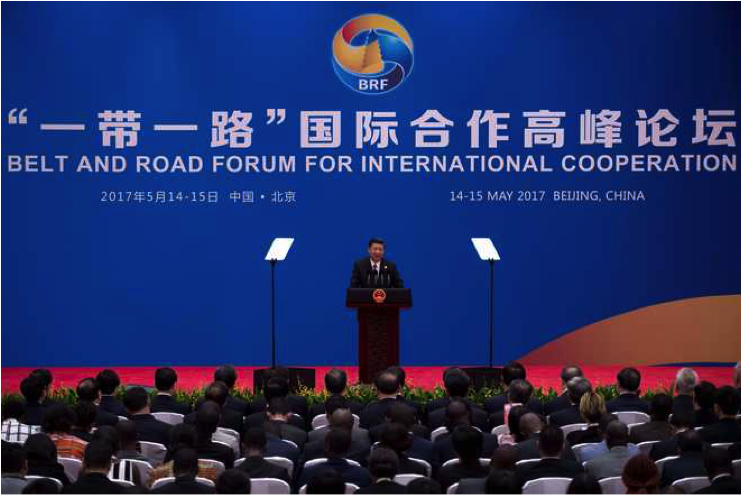
Thus BRI forms a critical component of China’s global strategy based on achieving three objectives: (a) establishing resource security by utilising ‘resources for infrastructure’ strategies, especially in resource-rich countries; (b) further consolidating its dominance over countries already within its sphere of influence, and (c) protecting its overseas assets by developing the global influence of its navy. China-watchers concede that fulfilment of the “Chinese dream” will fundamentally change China’s position and power relations with the rest of the world. As Tom Miller observes, until recently China’s diplomacy followed Deng Xiaoping's guarded maxim: ‘hide your brightness and seek obscurity’ but the new normal is: ‘to forge ahead’—to proactively shape China’s external environment.3 President Xi has undoubtedly been emboldened to deploy his “great-power diplomacy with Chinese characteristics” to re-shape and re-balance the world economic order at the very moment that Donald Trump is signalling US withdrawal from global leadership.
The BRI is best perceived as culmination of four decades of cumulative ‘reform and opening up’ policies in China. Its principal aim is to improve connectivity and integration in trade and financial exchanges as well as to promote mutual human bonds.
Indian Ambitions and the Revitalization of Indo-China Tensions
India too has begun to cultivate geostrategic ambitions as reforms deepen and its regional and global outreach increases. India dominates SAARC,4 has long-standing aspirations to become a permanent member of the UN Security Council, and is keen to re-establish leadership of the Global South through growing engagements with multilateral organizations. However a number of emergent challenges are raising economic and diplomatic tensions between India and China.
Given that India was over a decade behind in launching economic reforms, China not only outperformed India, it also increased its presence within India. Bi-lateral trade and investment have grown tremendously, however India’s bloating trade deficit with China ($53 billion in 2016) raises serious concerns. Ideally, India would like to pursue constructive dialogue, re-balance its trade and investment deficits, and engage China further in its ‘Make in India’ strategy.
Despite these overtures, regional security tensions are becoming more apparent, not least because India continues to host the Dalai Lama. Although Indo-China territorial disputes date back to British rule, diplomatic tensions have simmered since the 1962 war that left India militarily humiliated. Recent BRI-linked corridor projects have heightened tensions, especially the China-Pakistan Economic Corridor with India’s arch-enemy, the Bangladesh-China-India-Myanmar Economic Corridor on India’s eastern borders, and China’s port and naval base construction projects in the Indian Ocean. India views the BRI as a ‘pincer movement’, a platform for building a ‘string of pearls’ around ‘Mother India’s’ neck, threatening her sovereignty. India is also unhappy with China’s continued blockage of its membership in the elite Nuclear Suppliers Group, which it sees as crucial for realizing global ambitions.
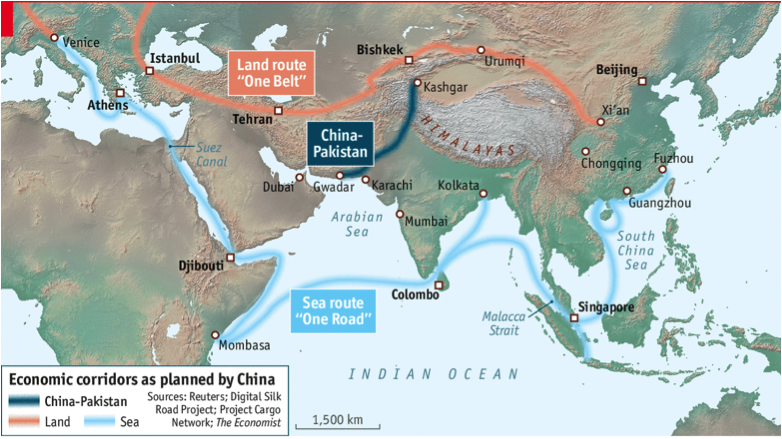
BRI and the China-Pakistan Economic Corridor
This changed reality is forcing India to re-think its options for the region. Should it continue building political capital with eastern neighbours and invest in non-confrontational diplomacy with China, or become more aggressive in countering Chinese threats? Given this dilemma, and despite being ruled by the stridently nationalist BJP, India struggles to articulate a decisive policy towards China – lambasting China’s South Asian ambitions at every opportunity but also wanting to share in the prosperity that BRI can potentially bring. Thus whilst questioning the entire premise of BRI, arguing that connectivity initiatives need to respect rule of law, be open and transparent when projects are awarded and that China should not create unsustainable debt burden for participating countries, it actively encourages Indian companies to tender for BRI-linked projects. India gleefully plays the democracy card—forgetting its abysmal development and human rights record in north-eastern states—recognizing that its smaller economic and geographical size places great constraints on mounting effective BRI challenges.
India also worries that the BRI could intensify its proxy war with Pakistan over Kashmir on its western border, and unleash yet another conflict on its eastern border.
‘Hindi-Chini Bhai-Bhai’ 5: Co-operation or Competition?
Despite worsening relations, some voices within India suggest that the countries’ mutual interests will be best served if they forge a partnership for regional development. By engaging in healthy competition, acting co-operatively, and managing inherent tensions through dialogue, they could both benefit from prosperous and peaceful coexistence and lead the Asian Century. A conflictual path, they suggest, would be disastrous for both, scuttling China’s BRI dream along with its projected image of a peaceful and responsible global leader, and stalling India’s drive towards modernity, thereby ruining regional and global aspirations for both countries.
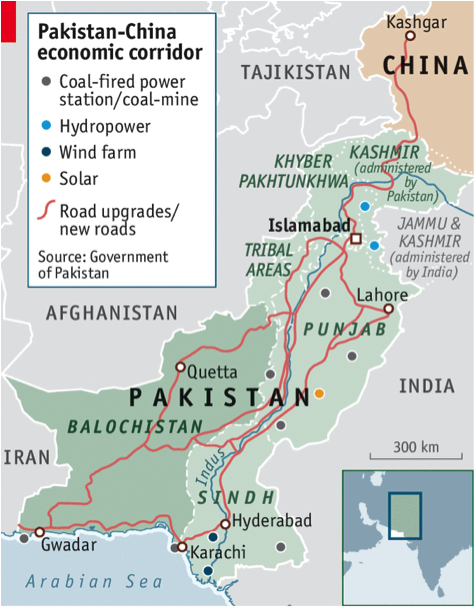
Planned CPEC routes and projects within Pakistan. Source: The Economist (2017)
So what are the prospects for a regional development partnership? Supporters of constructive dialogue argue that India should see the rise of China as an opportunity to develop trade complementarities. These would modernize India’s chronically weak and under-financed infrastructure (an example being Chinese bullet trains linking southern Indian cities) and upgrade the manufacturing sector by attracting further Chinese investment, already nearing $2 billion. India’s boycott of the Belt and Road Forum is considered a strategic blunder, potentially excluding India from major regional and global development initiatives and hurting Indian business. But critics counter that given the historic and strategic bad blood between India and China, and considering China’s geopolitical power game, India can’t afford to remain indifferent. Seizing opportunities offered by the recent U.S. pivot towards India at the expense of Pakistan, and strengthening an alliance with Japan, are advocated as being more critical in maintaining regional balance and security.6
Undoubtedly, Indian and Chinese economies and their bi-lateral relations have undergone a fundamental transformation over the past three decades, but neither country is willing to fully acknowledge this today and show appropriate deference. After all, they provide two contrasting political models. In reality neither places a tangible constraint on each other’s ambitions, but Cold War posturing and perceived military threats will sustain rivalry in South Asia in the near future, obscuring the possibility of mutual economic engagement.
1 The cultural or soft power dimension of China’s ‘going out’ policy is associated with
numbering around 1,000. See “Confucius says,” The Economist, September 13, 2014.
2 According to Elizabeth Economy of Council on Foreign Relations, President Xi sees
to reclaim China’s historic greatness and centrality in the world. She equates President
Xi’s political vision to a pyramid: “Xi Jinping sits on top of the Communist party, the
Communist party sits on top of China, and China sits on top of the world.” Quoted in
Tom Philips “Xi Jinping heralds 'new era' of Chinese power at communist party
congress,” The Guardian, October 18, 2017.
3 Tom Miller (2017). China’s Asian Dream: Empire Building along the New Silk Road.
4 South Asian Association for Regional Co-operation (SAARC) was established in 1985
Maldives, Pakistan, and Sri Lanka.
5 Literally translated as ‘Indians and Chinese are brothers’
6 During President Abe’s visit in September 2017, Prime Minister Modi boasted that Japan
Mumbai and Ahmadabad, signifying strengthening relationship with Japan. For
details see Sanjeev Singh “Narendra Modi’s bullet train project: too premature to
hail or condemn it,” Times of India, September 15, 2017.



